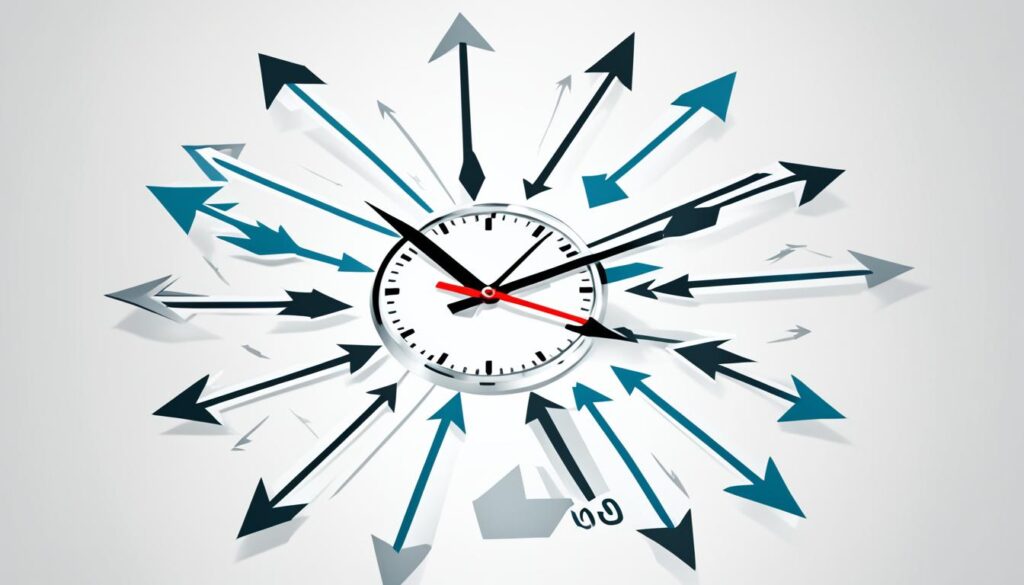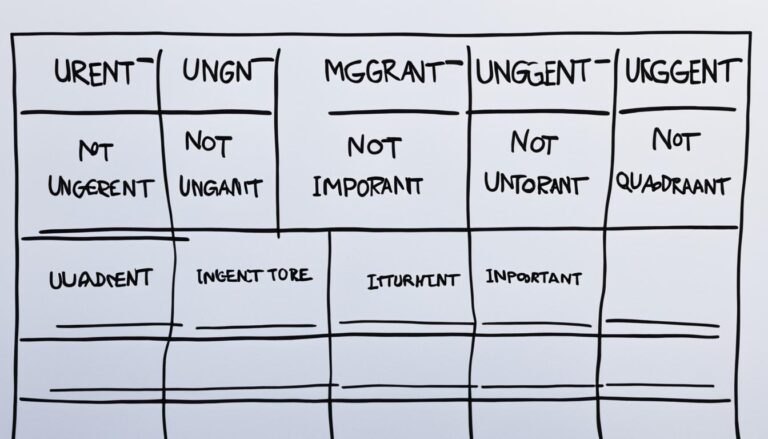Optimize Your Success: Master Cycle Time!

“Time is what we want most, but what we use worst.” – William Penn
In today’s fast-paced world, effective time management is crucial for maximizing productivity and achieving success. By mastering cycle time, which refers to the time it takes to complete a process or task, you can enhance operational efficiency and stay ahead in the production race. This article will provide you with strategies to optimize your cycle time and unlock your full potential.
Key Takeaways:
- Understanding cycle time and its impact on process efficiency.
- The importance of setting clear and measurable goals for efficient time management.
- Creating a schedule that allows for optimal time allocation.
- The negative effects of multitasking and the benefits of eliminating distractions.
- The importance of taking breaks and embracing work-life balance for long-term success.
Set Clear Goals for Efficient Time Management
When it comes to efficient time management, setting clear goals is an essential step. Having a clear understanding of what you want to achieve allows you to prioritize your tasks and create a strategic plan to accomplish them.
To ensure that your goals are actionable and effective, it’s important to make them specific, measurable, achievable, relevant, and time-bound (SMART). By following this framework, you can create goals that are realistic and attainable, increasing your chances of success.
Setting measurable goals is particularly important as it allows you to track your progress and stay motivated. Measurable goals provide tangible evidence of your achievements, giving you a sense of accomplishment and spurring you to keep going.
Prioritizing tasks based on their importance and urgency is another vital aspect of efficient time management. By evaluating the significance of each task and considering its deadline or impact on your overall goals, you can allocate your time and resources effectively.
Visualize your goals and tasks by creating a prioritized to-do list or using project management tools that can help you stay organized. Breaking down your larger goals into smaller, manageable tasks can also make them less overwhelming and easier to tackle.
By setting clear goals and prioritizing your tasks, you can focus on what truly matters and eliminate time-wasting activities. This approach not only enhances your efficiency but also increases your chances of achieving your desired outcomes.
Embrace the power of goal setting and watch as your time management improves, propelling you towards greater productivity and success.

Create a Schedule for Optimal Time Allocation
Now that you have set clear goals, it’s time to create a schedule that will help you make the most of your time. A well-designed schedule allows you to allocate dedicated time for specific tasks, giving you a sense of control over your day and reducing the chances of procrastination. With proper schedule creation, you can stay organized and optimize your time allocation effectively.
When creating your schedule, it’s important to consider your priorities, deadlines, and the amount of time you have available. By taking these factors into account, you can ensure that you allocate the right amount of time to each task and meet your goals efficiently.
To make schedule creation easier, utilize a planner, a digital calendar, or any other scheduling tool that suits your needs. These tools offer features that allow you to easily organize and manage your tasks, set reminders, and track your progress. Find a planner or digital calendar that you feel comfortable and confident using, as this will significantly contribute to your ability to stay organized and make the most of your time.
Remember, your schedule should be flexible enough to accommodate unforeseen circumstances and changes. Allow room for adjustments and be prepared to adapt as needed. By maintaining a well-managed schedule, you can make the most of your time and ensure that each task is given the attention and focus it deserves.
Now let’s explore some strategies for avo…
Avoid Multitasking and Eliminate Distractions
In today’s fast-paced world, many of us believe that multitasking is the key to getting more done in less time. However, studies have shown that contrary to popular belief, multitasking actually hampers productivity. Constantly switching between tasks not only leads to cognitive overload but also increases stress levels, resulting in decreased focus and efficiency.
To optimize your productivity, it is essential to focus on one task at a time. By dedicating your full attention to a single task, you can complete it more effectively and efficiently. Once you have finished one task, you can then move on to the next, ensuring each task receives your undivided attention and effort.
Eliminating distractions is another crucial element in improving focus and productivity. Today’s digital world is filled with constant distractions, from email notifications to social media updates. To stay focused, consider implementing strategies such as:
- Turning off notifications on your device
- Designating specific times to check and respond to emails
- Using website blockers or apps to limit time spent on social media
- Creating a quiet and clutter-free workspace
By minimizing distractions, you create an environment that fosters concentration and allows you to fully immerse yourself in your tasks.
Remember, staying focused and avoiding multitasking requires discipline and practice. Start by identifying your most important tasks and dedicating specific blocks of time solely to their completion. Over time, as you develop good habits, you will notice an increase in your productivity and overall performance.

| Distractions | Impact on Productivity |
|---|---|
| Constant notifications | Interrupts flow and concentration |
| Social media | Time-consuming and addictive |
| Noisy environment | Creates distractions and disrupts focus |
| Procrastination | Delays task completion and decreases productivity |
Eliminating distractions and focusing on one task at a time can significantly enhance your productivity and help you achieve better results in less time. Take control of your environment, prioritize your tasks, and watch your efficiency soar.
Take Breaks and Embrace Work-Life Balance
When it comes to maximizing your productivity and overall well-being, taking regular breaks is essential. Although it may seem counterintuitive, breaks are not a waste of time. In fact, they play a crucial role in recharging your energy, enhancing creativity, relieving stress, and maintaining optimal performance. So, don’t underestimate the power of breaks in optimizing your work-life balance.
By giving yourself permission to take breaks throughout the day, you allow your mind and body to rest and rejuvenate. Whether it’s a short walk, a few minutes of meditation, or simply stepping away from your desk, these moments of respite help prevent burnout and keep you refreshed and focused. Remember, breaks are not a luxury but a necessity for maintaining your productivity and overall well-being.
Embracing work-life balance is equally important for long-term success. Prioritize self-care and set boundaries to ensure that you have time for both your professional and personal life. Make it a habit to engage in activities that bring you joy and fulfillment outside of work. Whether it’s spending quality time with loved ones, pursuing a hobby, or practicing self-care rituals, make sure to allocate time for what truly matters to you.
Remember, achieving a healthy work-life balance is not just about striking the right balance between work and personal commitments. It’s about prioritizing your own well-being, happiness, and fulfillment. So, pause, take a break, and embrace the beauty of work-life balance to unlock your full potential and lead a more fulfilling life.





